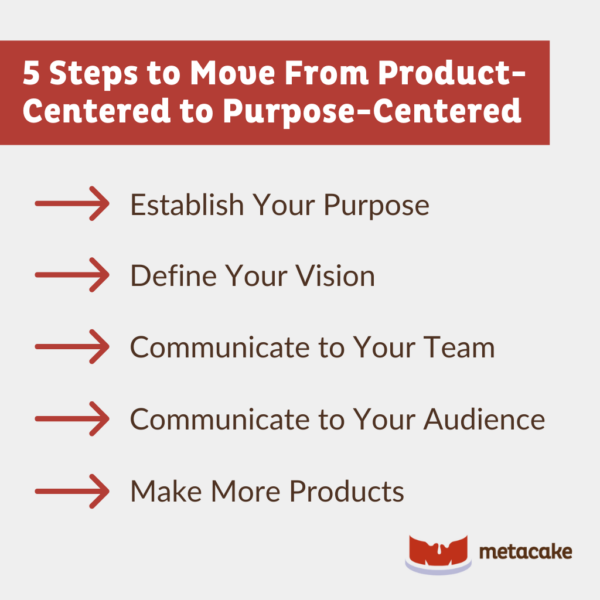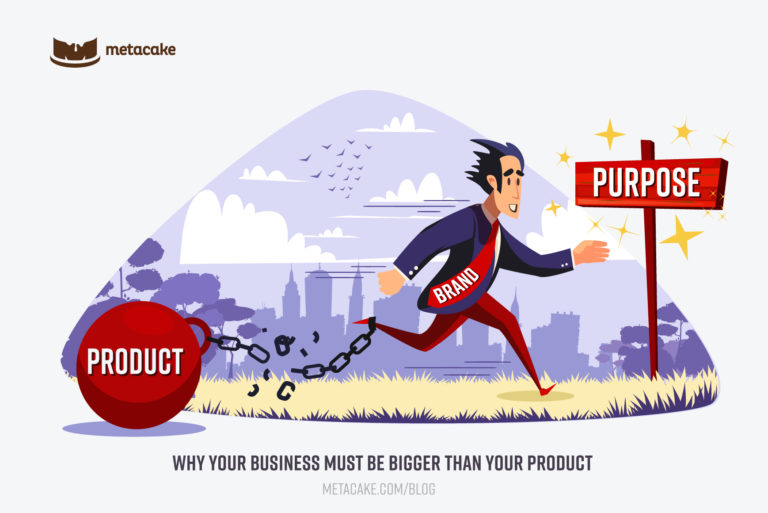What does your business sell?
If you’re like most people, you respond to that question with the product or service your company offers. After all, your business IS your product, right?
Wrong.
While it’s a common belief, equating your business with your product almost always slaps an expiration date on your brand influence and caps your potential success. The good news? The fix is a simple mindset shift. Simple, but profound.
Think of the most influential brands of our time: Apple, Tesla, Southwest, Nike, the list goes on. Every one of these businesses is more than their product. Apple is more than a phone, and Nike is more than a shoe.
Each of these businesses has a purpose.
How do you make the mindset shift from product to purchase? Let’s talk about why it’s important and how to apply it for improved brand influence, resilience, and longevity.
Cultivate Brand Influence Through Purpose
Most often, owners define their businesses by the products or services they sell for simplicity’s sake. They want their offerings to be easy for customers to understand and buy.
The problem? Things change. To stay relevant, products need to adapt to major market disruptions, like new trends and growing competition. If you turn a blind eye, your products can quickly become irrelevant, ineffective, or yesterday’s news.
Your product isn’t forever. But your purpose is.
Centering your company around its purpose is more than a nice thing to do. It’s a savvy, necessary business strategy that helps your brand withstand any climate; it’s a core element of becoming resilient.
From product-centered to purpose-centered, this simple but monumental mindset shift allows you to:
- Connect with your audience on a deeper level.
- Increase your brand influence.
- Adapt faster, no matter the economic conditions.
- Carry on, even in hard times.
- Make your business model more resilient, predictable, successful, and scalable.
This shift is what separates long-standing brands from companies that rise and fall with the times.
Spotted in the Wild: The Decline of Brand Influence
Product-centered ecommerce companies pop up constantly thanks to new trends in fashion, health, entertainment, etc. Sadly, unless they have a strong reason for existing, they don’t last more than a few years before they’re disrupted or fizzle out. Let’s look at a few real-life examples:
Death by Innovation
Some classic, softball examples of declining brand influence among product-centric companies include technological products rendered obsolete by innovation. Remember cassette tapes and VCRs? How about Kodak cameras?
If you build a company around one object, you infuse the business with its very own best-by date. Eventually, you’ll have to either redefine the entire company or watch it die.
Death by Transaction
Single-product businesses often run a transactional model, with no real brand supporting their product.
As an example, imagine a company that solely sells trade show displays. When COVID-19 hit in 2020, the live events industry screeched to a halt, effectively handcuffing companies that supplied event-specific products. That’s a death sentence to a company that only sells trade show displays.
If the same company centered its brand around a purpose rather than a product, they’d fare much better. Rather than an entire identity wrapped up in “we make trade show displays,” their deeper purpose would be “we help businesses share how awesome their products are.” With that goal, trade show displays become one of many avenues to take, and the company can easily pivot to other offerings when needed.
Coming Out on Top: When Brand Influence Survives
Not every example is a sad story of decline! And not every success story is a juggernaut like Nike.
Plenty of brands have kept a keen eye toward trends and change, maintaining their influence and market share by focusing on the purpose behind their initial product. Here’s one great example:
Adapt and Thrive
In the beginning, TOMS made one basic shoe that quickly became trendy. A pair of original TOMS was THE comfy shoe to have for a time, but today they’ve fallen out of the zeitgeist.
So why are they still in business?
As you probably know, the company’s mission was never just about selling a killer shoe. From the beginning, the brand’s core identity centered on giving back to those in need — part of what led to their popularity in the first place. The shoe itself was in service of the purpose; it wasn’t the whole point.
This mindset gave TOMS room to innovate when they needed to. Their entire brand wasn’t tied to one trademark shoe style. These days, they make boots, sandals, and heels, plus sunglasses, eyeglasses, and a few pet accessories. Their give-back purpose remains at the center of their brand influence, allowing them space to adapt their products as trends, opportunities, and needs change over time.
Is Your Business Too Product-Centered? 5 Questions
How do you know if your business is too product-centered? Ask these five questions to help determine whether a more purpose-centered mindset could benefit your brand.
1. Do you have a bigger vision than what you sell?
Are you purely in business to make and sell a popular item? If so, you may not want a larger purpose. If you do, however, follow the five steps in the next section.
If you think you already have a vision or purpose behind your product, do others in your business know about it? Everyone on your team should have a deep understanding of your brand’s purpose so it consistently comes through in every area of your business.
2. Does your marketing talk only about product features and benefits?
If your marketing sticks strictly to spelling out buttons, batteries, and functions, it’s product-focused. A business with purpose uses marketing to emphasize the results a product produces, how it changes an area of the customer’s life.
3. Are you innovating on your product?
Products and services that rest on their laurels can survive for a time, but they ultimately suffer a Blockbuster-style decline.
We can’t stress the importance of this enough: Improving your flagship product (and adding more complementary products) is critical for increasing average order value, customer lifetime value, customer advocacy, and brand influence that lasts.
Related to product vs. purpose mindset, the questions you ask when considering innovation are telling. Is it, “How do we make a better VCR?” or “How can I make media come to life for families who love watching movies?”
4. Do you have only one product?
If you only have one product, you limit the ways and frequency with which people can interact with your brand. Expanding your product line is crucial for long-term success. If you have several products, ask yourself whether customers will only buy once, or if there’s a reason for them to come back.
5. What happens if your main product becomes irrelevant?
What happens if innovation renders your product obsolete? Or if supply chain issues interfere with production? Or another lockdown sends everyone home?
Will it put you out of business? Will you have to go back to the drawing board and start from scratch? Or could you quickly introduce a new product that falls in line with your purpose?

Protect Your Brand Influence: From Product-Centered to Purpose-Centered in 5 Steps
If you think your business is more product-centered, it’s not too late to course correct — but you’ll want to start now. Follow these five steps to start moving from product-centered to purpose-centered today.
1. Establish Your Purpose
To begin, ask yourself why your business exists. If you need to, start at a high level and dig deeper using a variation on the Five Whys technique. In other words, ask yourself “why” until you strike the core of your mission.
Long-standing businesses sometimes have a deeper purpose, but it gets lost over time. Maybe it becomes watered down or miscommunicated. Maybe your current product development team has never of it. If this is you, re-identify that original purpose and evaluate whether it’s still your purpose today. Adjust if necessary.
2. Define Your Vision
Take your “why” (your purpose) and cast a vision for your brand. This vision should transcend your products and reflect why you exist.
3. Communicate to Your Team
Once you’ve defined a purpose and vision for why your company exists, communicate them to your team, especially to those involved in innovation, product development, and marketing. When everyone has a deep understanding of your brand’s purpose, you’ll be able to develop products and market them with a consistent, powerful message.
4. Communicate to Your Audience
Your audience needs to hear your message. Elements of your brand purpose can appear in places like your about page, product pages, blog content, email marketing, Facebook ads, and more.
People rally much more enthusiastically around a purpose than they do around a product. This goes back to an idea we talk about often — consumers make purchase decisions based on emotions far more often than facts.
5. Make More Products
Once you have your purpose dialed in and are communicating it on your site and through your marketing, it’s time to think bigger. Develop more products!
This takes dedicated resources, but it can’t be put on the back burner. The key is to have new products in the works before you need them. For more info on developing your product line, check out our post, It’s Time to Rethink R&D for Ecommerce.
Purpose: The Secret Ingredient to Brand Influence and Longevity
If you want to take your business to the next level so you can cultivate brand influence and increase longevity, defining your purpose with the exercises above is the best place to start.
For more guidance on developing a business with a defined brand and deep purpose, check out our series of articles on Building a Brand That Lasts Forever.
